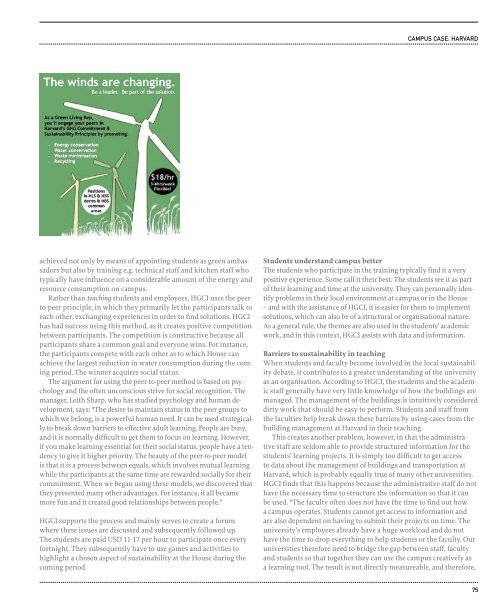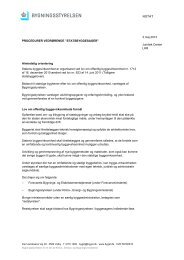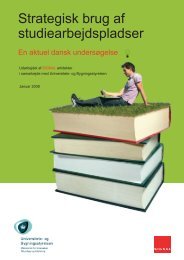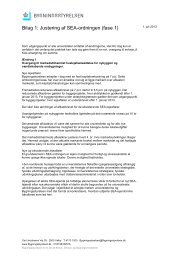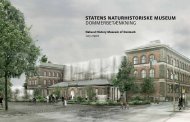Campus og studiemiljø - Bygningsstyrelsen
Campus og studiemiljø - Bygningsstyrelsen
Campus og studiemiljø - Bygningsstyrelsen
You also want an ePaper? Increase the reach of your titles
YUMPU automatically turns print PDFs into web optimized ePapers that Google loves.
achieved not only by means of appointing students as green ambassadors<br />
but also by training e.g. technical staff and kitchen staff who<br />
typically have influence on a considerable amount of the energy and<br />
resource consumption on campus.<br />
Rather than teaching students and employees, HGCI uses the peerto-peer<br />
principle, in which they primarily let the participants talk to<br />
each other, exchanging experiences in order to find solutions. HGCI<br />
has had success using this method, as it creates positive competition<br />
between participants. The competition is constructive because all<br />
participants share a common goal and everyone wins. For instance,<br />
the participants compete with each other as to which House can<br />
achieve the largest reduction in water consumption during the coming<br />
period. The winner acquires social status.<br />
The argument for using the peer-to-peer method is based on psychol<strong>og</strong>y<br />
and the often unconscious strive for social rec<strong>og</strong>nition. The<br />
manager, Leith Sharp, who has studied psychol<strong>og</strong>y and human development,<br />
says: “The desire to maintain status in the peer groups to<br />
which we belong, is a powerful human need. It can be used strategically<br />
to break down barriers to effective adult learning. People are busy,<br />
and it is normally difficult to get them to focus on learning. However,<br />
if you make learning essential for their social status, people have a tendency<br />
to give it higher priority. The beauty of the peer-to-peer model<br />
is that it is a process between equals, which involves mutual learning<br />
while the participants at the same time are rewarded socially for their<br />
commitment. When we began using these models, we discovered that<br />
they presented many other advantages. For instance, it all became<br />
more fun and it created good relationships between people.”<br />
HGCI supports the process and mainly serves to create a forum<br />
where these issues are discussed and subsequently followed up.<br />
The students are paid USD 11-17 per hour to participate once every<br />
fortnight. They subsequently have to use games and activities to<br />
highlight a chosen aspect of sustainability at the House during the<br />
coming period.<br />
<strong>Campus</strong> Case: Harvard<br />
students understand campus better<br />
The students who participate in the training typically find it a very<br />
positive experience. Some call it their best. The students see it as part<br />
of their learning and time at the university. They can personally identify<br />
problems in their local environment at campus or in the House<br />
– and with the assistance of HGCI, it is easier for them to implement<br />
solutions, which can also be of a structural or organisational nature.<br />
As a general rule, the themes are also used in the students’ academic<br />
work, and in this context, HGCI assists with data and information.<br />
Barriers to sustainability in teaching<br />
When students and faculty become involved in the local sustainability<br />
debate, it contributes to a greater understanding of the university<br />
as an organisation. According to HGCI, the students and the academic<br />
staff generally have very little knowledge of how the buildings are<br />
managed. The management of the buildings is intuitively considered<br />
dirty work that should be easy to perform. Students and staff from<br />
the faculties help break down these barriers by using cases from the<br />
building management at Harvard in their teaching.<br />
This creates another problem, however, in that the administrative<br />
staff are seldom able to provide structured information for the<br />
students’ learning projects. It is simply too difficult to get access<br />
to data about the management of buildings and transportation at<br />
Harvard, which is probably equally true of many other universities.<br />
HGCI finds that this happens because the administrative staff do not<br />
have the necessary time to structure the information so that it can<br />
be used. “The faculty often does not have the time to find out how<br />
a campus operates. Students cannot get access to information and<br />
are also dependent on having to submit their projects on time. The<br />
university’s employees already have a huge workload and do not<br />
have the time to drop everything to help students or the faculty. Our<br />
universities therefore need to bridge the gap between staff, faculty<br />
and students so that t<strong>og</strong>ether they can use the campus creatively as<br />
a learning tool. The result is not directly measureable, and therefore,<br />
75


